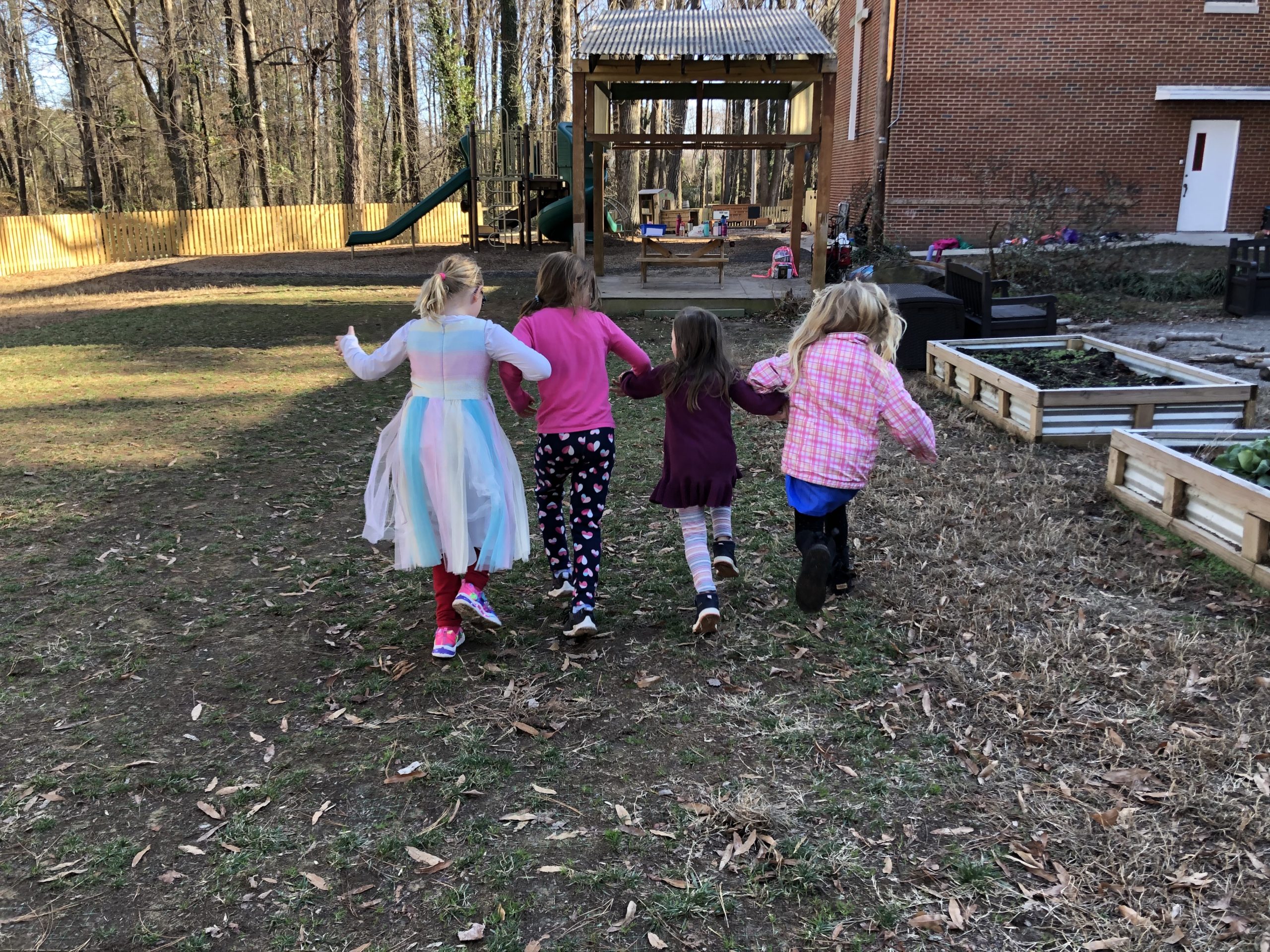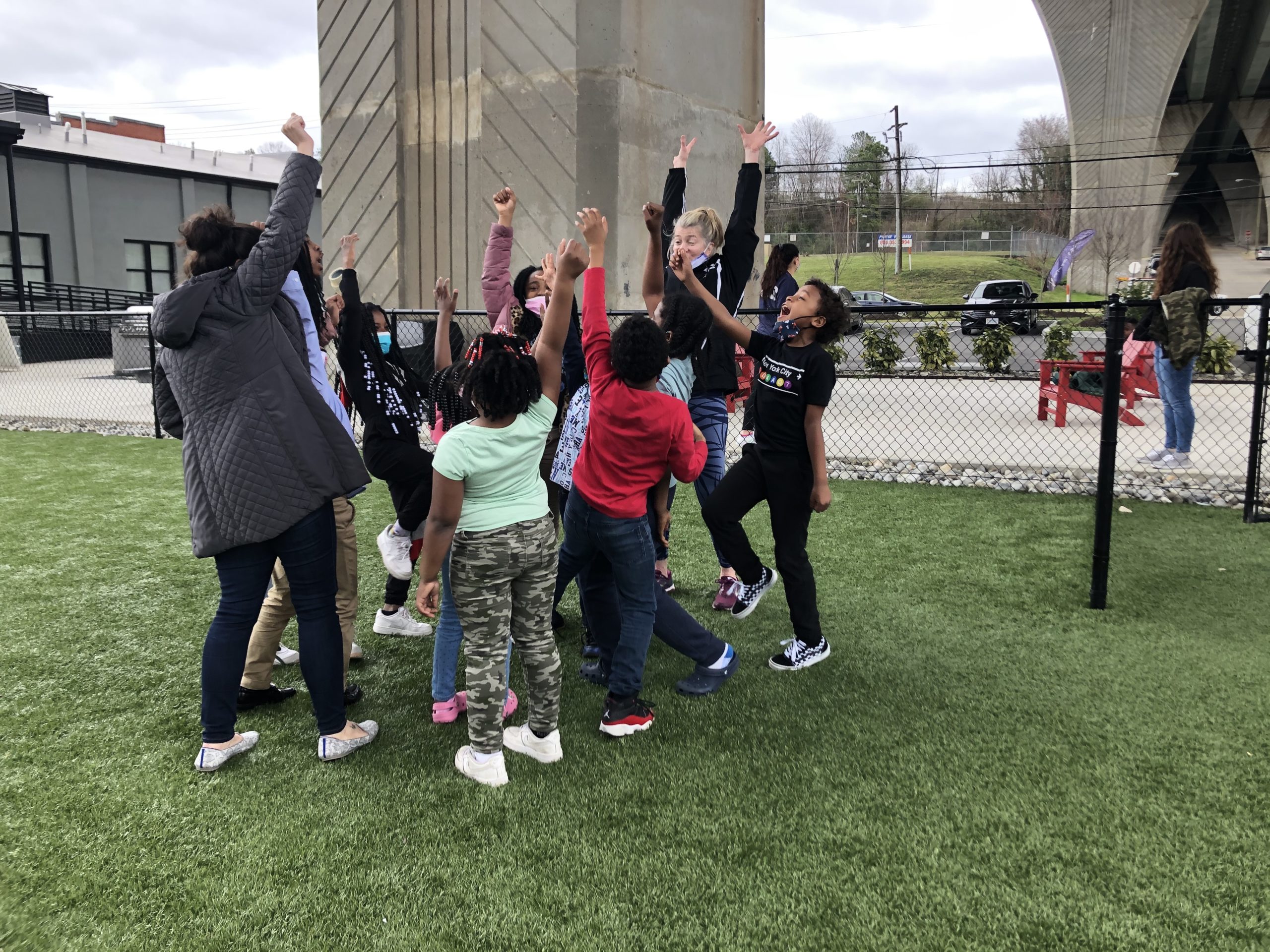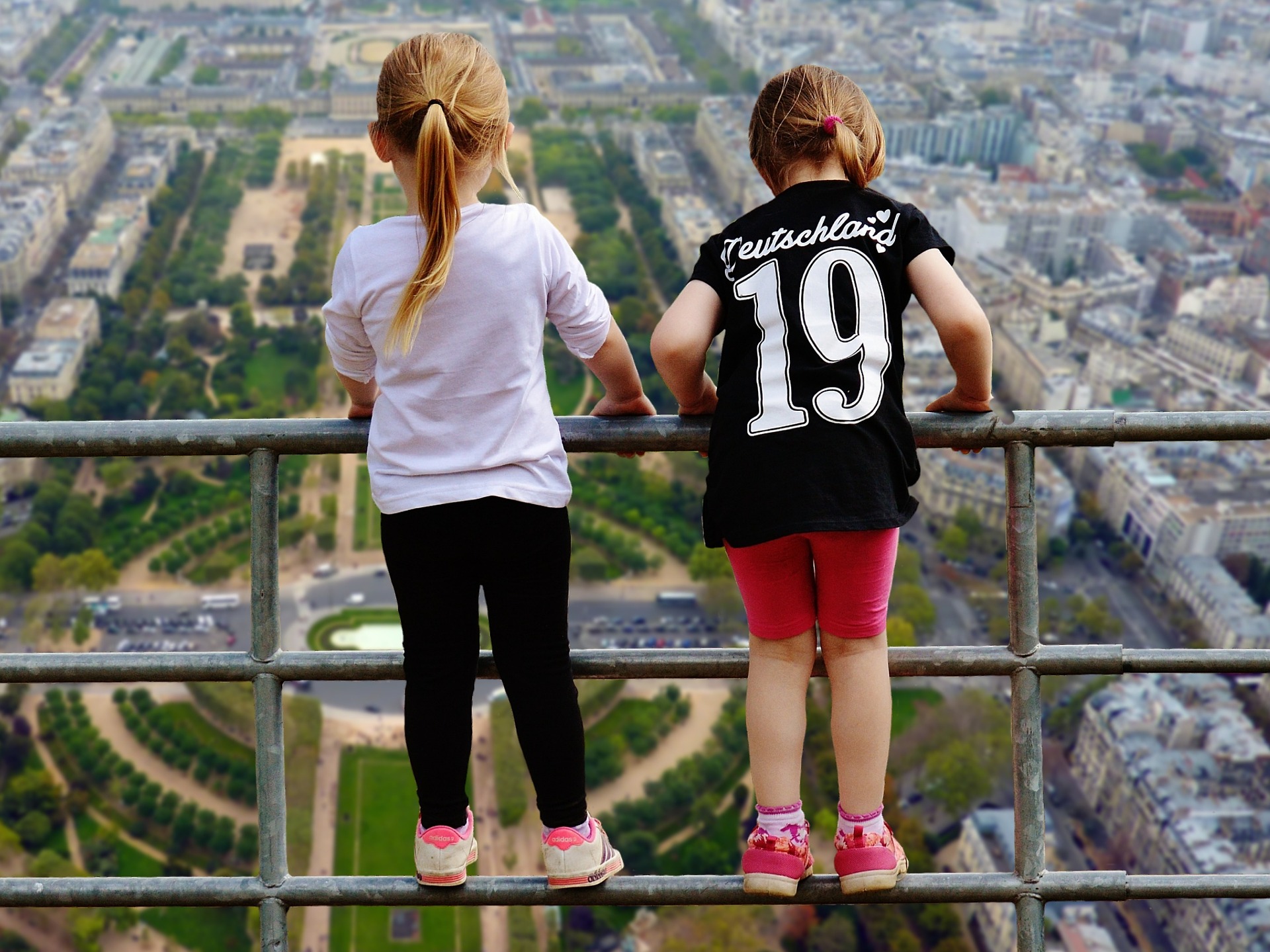A few weeks ago, I received an email from a teacher who had heard me speak at an educators conference. She shared a recent experience, looking for confirmation that her approach was the correct choice. Outside her classroom door, some of the children had spotted a spider. They had been studying spiders, so she allowed them to go outside to get a better look. After a few minutes of study, the children lost interest and began to run on the open black top and attached sidewalk. Her gut reaction was to let them run, but an observer from one of the local agencies voiced great concern for the borderline chaos, worrying that the children would get hurt. (Her school is surrounded by concrete and pavement, without a grassy or mulch area for running.) When one or two did stumble and fall, the observer was quick to point a condemning finger, shaking the teacher’s confidence in her gut instinct to let them play.
Breaking down the situation, there are many things at work here. The children instinctively ran with abandon because it felt good, firing up some good old-fashioned neural brain activity. Running with joy helped them move their bodies to build strength and explore their abilities as biology and evolution intended them to.
It was also a fabulous lesson in appropriate risk. How fast can I run on this blacktop without falling down? What happens if I do fall down? Is that possible bad outcome worth the joy I feel when running and playing with my friends? Will I have as much fun if I slow down a little, thereby reducing my risk of falling down? Too often, we adults limit risk exposure for children with the best of intentions. No one likes to bandage a bloody knee. But, I will argue that eliminating the chance of a scuffed knee does far more harm than good.
A word about risk. In this context, I am talking about age appropriate risk. No one is arguing that we should let four year olds drive cars or three year olds wander along busy roads. I am talking about running a little too fast, climbing a little too high, jumping a little too far. These risks are the ones that make adults draw in their breaths a little and wonder if it is really OK. I am arguing that it is more than OK – it is essential.
Children need risky play to develop physically, socially and emotionally. The physical development is pretty obvious, but missed by too many adults. You can’t develop your vestibular system if you never test it. So, climb on that rickety structure and see what you need to do with your body to keep from toppling. You can’t develop your proprioceptive system if you never push it. So, roll down that huge hill and see how it feels to be jostled and bounced. You cannot get faster if you are always walking carefully. And, you can’t get stronger if you are always safely on the ground.
More than that, children need risky play to strengthen their self-confidence, resilience, risk management skills and problem solving while also developing a healthy sense of pride. Just like physical skills, these social and emotional skills have to be pushed to develop. Children develop resilience by having to live through and overcome lousy situations, like falling down and scraping a knee. From that scraped knee, they learn that sometimes things go wrong. And, they learn that they can overcome that situation and move along with their day. Children develop self-confidence by doing something hard that they didn’t think they could do. There is nothing more confident than a child who runs up the slide successfully for the very first time. Children learn problem solving by – you guessed it – solving problems. “How can I reach that pretty leaf up in that tree?” is likely to lead to some risky play, but it will definitely lead to some amazing problem solving.
Studies show that children who engage in risky play have a reduced risk of injury, rather than a higher risk of injury, because they have learned to accurately assess risk. In fact, most children actually know their limits. They innately know the edge and how far to push it. But, if we never allow them to investigate the edge, they are more likely to feel vulnerable and less self-assured. Watch a mixed-developmental level group of children play in the same space. The more developed kids will push the risk level to a place that gives adults pause. The less developed kids will stay in a more moderate range, finding their own edge.
Risk is developmentally necessary for children to evolve into properly functioning adults. Risky play allows us to experiment and test boundaries. As adults we must take calculated risks all the time. We learned how to do this by taking calculated risks as children: jumping out of swings, climbing up slides and hanging upside down on the monkey bars.
So, where do we find appropriate risks for young children? One of the best places to find risk and learn from it is outside, on a playground or in nature. Norwegian researcher, Ellen Sandseter, of Queen Maud University in Trondheim, Norway, has identified six areas of children’s risky play that are all available outside.
- Heights. Children love to climb just a little too high. It allows them to look at the world from a different vantage point and see the world in a different light, finding that they fit into it in a new way. Additionally there is an immense feeling of success that comes from reaching a new height.
- Speed. I see this all the time when children enter the movement room for big body physical play in our Pop, Hop & Rock™ classes. They love to careen as fast as possible into the room and around it. They also do this on tricycles, swings and scooters. There is nothing like the joy on the face of a child running full tilt down a hill. Dr. Sandseter argues that they will only reach a speed at which they can still maintain control, rarely crossing the control line, so they get the thrill of speed without the peril.
- Dangerous tools. Children know there is risk with dangerous tools, but they are attracted to them whether it is knives, construction tools or farm machinery. When children are shown by an adult how to use dangerous tools safely, there is an immense satisfaction knowing the trust that the adult has placed with the child. They focus on the task at hand because they know that a mistake could hurt. Again, no one is arguing that you should let a three year old drive a tractor. But, a three year old can use a hammer or a hand saw with a caring adult by her side.
- Dangerous elements. Children are fascinated by elements like fire and deep water. Like dangerous tools, there is satisfaction in the trust that goes with managing these dangerous situations. Working with these elements in an age appropriate way, like toasting marshmallows over a campfire, with a trusted adult teachers a healthy respect for dangerous elements.
- Rough and tumble play, also known as roughhouse play. Children, like the young of most mammals, love to run, chase and wrestle. It is even more fun if you are the underdog and you manage to triumph. Dr. Sandseter identified this type of play as risky because it takes significantly more skill for the underdog to escape the arms of the pursuer, and the underdog faces risk of being hurt. Success here can be enormously thrilling and confidence building. As with the use of dangerous tools or interaction with dangerous elements, rough and tumble play requires the involvement of a trusted adult. Studies have found that when parents engage in rough house play, giving their children a scare and some practice losing, children develop resilience which is essential for a productive life. For educators, this type of play presents a real challenge to prevent it from crossing over to aggressive play which can be physically and emotionally damaging. All children involved must feel empowered by the play, not threatened. Here are some guidelines on including rough and tumble play into a school setting.
- Disappearing. This is that department store moment when the child hides in the middle of the clothing rack and disappears from view. To him, this disappearing is a great game of hide and seek, providing an enormous thrill. It also builds self-reliance as he assesses the risk of being left behind or truly lost.
We adults sometimes lose sight of the bigger picture as we assess risk. For example, in a local county, many elementary schools house Head Start and similar preschool programs. For years, these preschoolers used the same playground equipment as the rest of the elementary school children, with few problems. In 2016, the county Parks and Recreation department labeled all the playground equipment in the county school systems as “For use by children ages 5 and above,” barring the preschoolers from the playgrounds. On so many levels, this was misguided. For one, age is a poor determinant of development. Many preschoolers are larger and more skilled than a typical Kindergartener. And, many young elementary-age children are smaller and less coordinated than some preschoolers. Using age as a defining prerequisite for developmental capacities is grossly negligent. Second, these preschool-aged children have used this equipment for years with no outcry from the teachers or parents. The children had shown that they were capable of using the playground effectively. Finally, and worst of all, the county made this sweeping decision to prohibit their 4 year old constituency from using the playgrounds without providing alternative playground equipment. Given everything we know about the importance of physical play for preschoolers, leaving them to play on empty field with only some balls or hula hoops is shameful.
So, how can adults give children space for risky play? How do you overcome that sharp intake of breath and the desire to shout, “Stop!”? Here are some tips.
- The 17 second rule. Allow the play to continue for 17 seconds out of your comfort zone and see if the children can noodle out the edge of their play or exploration. Usually that 17-second time frame allows either the adult or the child – or both – to learn a valuable lesson.
- Understand the actual risk. A skinned knee is not the end of the world. While we all want to avoid broken bones or worse, some scuffed elbows or bumped shins are signs of age appropriate play. We should worry more if we never need a bandaid or an ice pack on the playground.
- Ask “What is your plan?” Often, what looks like unbridled thrill-seeking to us is really part of a carefully considered plan that we just don’t see. Walk over to the play, ask politely for a brief time-out, and inquire about the plan. It may be that once you understand the goal, the risky play looks less perilous.
- Be honest about your feelings. There are times when children really do mis-evaluate risk. Often, they do not see the risks outside of their own bodies. They know how fast they can run without falling, but they may not see the chain link fence at the bottom of the hill. You see the fence and your anxiety level shoots through the roof. Then, try saying something like, “I can see how much fun you are having running down the hill. I am worried about the fence at the bottom of the hill. I am worried you will get hurt. How can we change the game so I don’t have to worry about the fence?” The vast majority of the time, children will come up with a perfectly good solution to lessen your concerns while maintaining the risk-and-reward of the play.
It is time to loosen the reigns a bit and let children freely test their limits, flex their risk muscles, and find their inner resourcefulness and strength. If we do, we adults will actually be able to relax more in the long run while our children manage and assess risk all the way into adulthood.
Citations
Toole, Brittany. Risky Play for Children: Why We Should Let Kids Go Outside Then Get Out of the Way. 1/20/19 www.cbc.ca
Yogman M, Garner A, Hutchinson J, et al; AAP COMMITTEE ON PSYCHOSOCIAL ASPECTS OF CHILD AND FAMILY HEALTH, AAP COUNCIL ON COMMUNICATIONS AND MEDIA. The Power of Play: A Pediatric Role in Enhancing Development in Young Children. Pediatrics. 2018;142(3):e20182058
Blincoe, Kate. Risk is Essential to Childhood as are Scrapes, Grazes, Falls and Panics. www.theguardian.com. 10/14/15
“I love this curriculum!”
-Teacher, Verona, PA

Are you a teacher? Check out our curriculum!
Proven games and activities to get kids active for improved learning and behavior. These packages target kids 3-5 years old and are our go-to favorite games that repeatedly bring squeals of joy and sweaty-faced smiles.
Full year curriculum for 3-5 year olds
Mini Curriculum for 3-5 year olds with 1 hour of professional development
Summer Curriculum for 3-5 year olds.

Ready to become Pivot to Play Certified® with your own business?
If you love kids and crave being your own boss, this is for you. How can you not have the best job in the world when all day long you play games? The Pivot to Play® Certification gives you the why’s, how’s and tools you need to set up your business affecting real change in your own community. This is not a franchise, so you do not pay franchise fees. You have a license to be a Pivot to Play® Coach, using our proven methods to get kids active in schools.
Learn more here.
